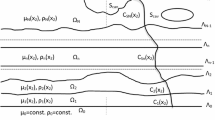Abstract
Piecewise heterogeneous media that the earth presents are composed of large-scale boundary structures and small-scale volume heterogeneities. Wave propagation in such piecewise heterogeneous media can be accurately superposed through the generalized Lippmann–Schwinger integral equation (GLSIE). Two different Born series modeling schemes are formulated for the boundary–volume integral equation with 2-D antiplane motion (SH waves). Both schemes decompose the resulting boundary–volume integral equation matrix into two parts: the self-interaction operator handled with a fully implicit manner, and the extrapolation operator approximated by a Born series. The first scheme associates the self-interaction operator with each boundary itself and the volume itself, and interprets the extrapolation operator as the cross-interaction between each boundary and other boundaries/volume scatterers in a subregion. The second scheme relates the self-interaction operator to each boundary itself and its cross-interaction with the volume scatterers on both sides, and expresses the extrapolation operator as both the direct and indirect (through the volume scatterers) cross-interactions between different boundaries in a subregion. By eliminating the displacement field from the volume scatterers, the second scheme reduces the dimension of the resulting boundary-volume integral equation matrix, leading to a faster convergence than the first scheme. Both the numerical schemes are validated by dimensionless frequency responses to a heterogeneous alluvial valley with the velocity perturbed randomly in the range of ca 5–20 %. The schemes are applied to wave propagation simulation in a heterogeneous multilayered model by calculating synthetic seismograms. Numerical experiments, compared with the full-waveform numerical solution, indicate that the Born series modeling schemes significantly improve computational efficiency, especially for high frequencies.














Similar content being viewed by others
References
Abramowitz, M., and Stegun, I.A. (1968). Handbook of Mathematical Functions, Dover Publications Inc, New York, 358–364.
Bouchon, M. (1982). The Complete Synthesis of Seismic Crustal Phases at Regional Distances, J. geophys. Res. 82, 1735–1741.
Bouchon, M., Campillo, M. and Gaffet, S. (1989). A Boundary Integral Equation-discrete Wavenumber Representation Method to Study Wave Propagation in Multilayered Media Having Irregular Interfaces, Geophysics 54, 1134–1140.
Brebbia, C. A., and Walker, S. (1980). Boundary element techniques in engineering, Newnes-Butterworths, London.
Campillo, M. (1987). Modeling of SH-wave Propagation in an Irregularly Layered Medium-Application to Seismic Profiles Near a Dome, Geophys. Prospect. 35, 236–249.
Campillo, M., and Bouchon, M. (1985). Synthetic SH-seismograms in a Laterally Varying Medium by the Discrete Wavenumber Method, Geophys. J. R. astr. Soc. 83, 307–317.
Chen, X. F. (1990). Seismogram Synthesis for Multilayered Media with Irregular Interfaces by Global Generalized Reflection/Transmission Matrices Method. I. Theory of Two-dimensional SH Case, Bull. seism. Soc. Am. 80, 1696–1724.
Chen, X. F. (1995). Seismogram Synthesis for Multi-layered Media with Irregular Interfaces by Global Generalized Reflection/Transmission Matrices Method. II. Applications of 2D SH Case, Bull. seism. Soc. Am. 85, 1094–1106.
Fu, L. Y. (2002). Seismogram Synthesis for Piecewise Heterogeneous Media, Geophys. J. Int. 150, 800–808.
Fu, L. Y. (2003). Numerical Study of Generalized Lipmann–Schwinger Integral Equation Including Surface Topography, Geophysics 68, 665–671. doi:10.1190/1.1567236.
Fu, L.Y., and Bouchon, M. (2004). Discrete Wavenumber Solutions to Numerical Wave Propagation in Piecewise Media Heterogeneous Media – I. Theory of Two-dimensional SH Case, Geophys. J. Int. 157, 481–498. doi:10.1111/j.1365-246X.2004.02135.x.
Fu, L.Y., and Wu, R. S. (2001). A Hybrid BE-GS Method for Modeling Regional Wave Propagation, Pure Appl. Geophys. 158, 1251–1277.
Ge, Z., and Chen, X. F. (2008). An Efficient Approach for Simulating Wave Propagation with the Boundary Element Method in Multilayered Media with Irregular Interfaces, Bull. seism. Soc. Am. 98, 3007–3016. doi:10.1785/0120080920.
Pao, Y. H., and Varatharajulu, V. (1976). Huygens’ principle, radiation conditions and integral formulas for the scattering of elastic waves, J. Acoust. Soc. Am. 59, 1361–1370.
Russell, R. D., and Shampine, L. F. (1972). Collocation method for boundary value problems, Numer. Math. 19, 1-28.
Sanchez-sesma, F. J., and Campillo, M. (1991). Diffraction of P, SV and Rayleigh Waves by Topographic Features: a Boundary Integral Formulation, Bull. Seism. Soc. Am. 81, 2234–2253.
Schuster, G. T. (1985a). A Hybrid BIE + Born Series Modeling Scheme: Generalized Born Series, J. Acoust. Soc. Am. 77, 865–879.
Schuster, G. T. (1985b). Solution of the Acoustic Transmission Problem by a Perturbed Born Series, J. Acoust. Soc. Am. 77, 880–886.
Schuster, G. T. (1985c). Modeling Structural Traps by a Hybrid Boundary Integral Equation and Born Series Method, Soc. Expl. Geophys., Expanded Abstracts 4, 483–487.
Schuster, G. T., and Smith, L. C. (1985). Modeling Scatterers Embedded in Plane-layered Media by a Hydrid Haskel-Thomson and Boundary Integral Equation Method, J. Acoust. Soc. Am. 78, 1387–1394.
Yu, G. X., Fu, L.Y., and Yao, Z. X. (2010). Comparison of Different BEM + Born Series Modeling Schemes for Wave Propagation in Complex Geologic Structures, Geophysics 75, T71–T82. doi:10.1190/1.3392175.
Acknowledgments
The research was supported by the Natural Science Foundation of China (Grant Nos. 41204097, 41130418 and 40925013).
Author information
Authors and Affiliations
Corresponding author
Rights and permissions
About this article
Cite this article
Yu, GX., Fu, LY. Approximate Solutions to the Boundary–Volume Integral Equation for Wave Propagation in Piecewise Heterogeneous Media. Pure Appl. Geophys. 170, 1803–1819 (2013). https://doi.org/10.1007/s00024-012-0638-6
Received:
Revised:
Accepted:
Published:
Issue Date:
DOI: https://doi.org/10.1007/s00024-012-0638-6




